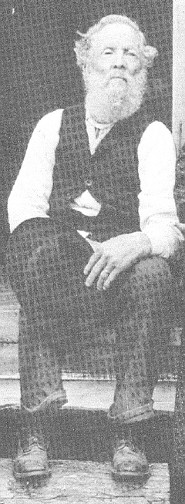.Ira Robinson
Isham 1810-1906 (Picture 1896)

Claims to Be Oldest Living
Resident of State
Ira Isham of Sawyer County,
Came to Wisconsin Early
- First Sheriff of Chippewa
County
Ira Isham, Sawyer County, proudly claims the distinction of having been
a resident of Wisconsin longer than any other white man now living, at
least in the northern half of the state.
His career has been an extraordinary one. He was born in Vermont in the
year 1810, ninety-six years ago, but came to Chippewa Falls with his father,
who was an Indian trader, when a child. On their way west the Isham
family rode on the first the first passenger train operated in America,
over the old Boston and Maine Railroad, about the year 1830. The
train was drawn by horses, and they traveled at the then marvelous rate
of seventy-five miles a day.
At the age of twenty-eight Mr. Isham married Paf.ki.ink, a quarter-blood
Chippewa woman, with whom he lived for fifty-seven years, until her death
last spring. As the off spring of this marriage there were thirteen
children, eleven of whom are yet living; ninety-two grandchildren and eighteen
great-grandchildren. Of the grandchildren forty-seven are living
and forty-five are dead.
Mr. Isham was the first sheriff of Chippewa County, which then embraced
a great portion of Northern Wisconsin. In this capacity he had many
encounters and narrow escapes from the lawless element, which then pervaded
the region. On one occasion he fought and captured three desperados
who were armed with a scythe, a pitchfork and a rifle respectively, after
desperately wounding one of their number. It was during his incumbency
of the sheriff office that he made the acquaintance of General Winfield
Scott and Col. Jefferson Davis, later president of the Southern Confederacy,
but at the time an officer in the United States Army, and then engaged
in the work building Fort Prairie du Chein.
The venerable gentleman now lives on his farm near the village of Court
de Oreilles, where he does his own work with neatness and expedition that
would do credit to a man many years his junior.
--Transcribed from: Chippewa
Falls Independent - dated October 29,1905
--Also transcribed from
a later edition of the Chippewa Falls Independent:
"THE ISHAM FAMILY"
An Interesting Story and
a Correction That Will Help Future Historians
Editor Independent. Dear
Sir:
I wish to make a little
correction to an article in your Sunday issue of the 23rd. It alludes to
an early day friend of mine and read as follows:
"Ira Isham was among the
early residents of Chippewa Falls, and known to many old timers. He was
an Indian and raised a large family." which is correct, all but that "he
was an Indian".
Ira was a thorough full-blooded
Yankee, born in the state of Vermont. and came to Menomonie, Wis., in 1847,
and the to Chippewa Falls, where he worked in the sawmill for H.S. Allen
and became one of the best saw filers in the big mill, and like all the
early settlers,married an Indian wife, and lived in a small house built
in the rear of the present Dick Kunsman saloon, and raised a family of
thirteen children. He was a great deer hunter and rifle shot, and was the
deputy sheriff who shot and wounded and captured Donaldson and put him
in the company's root house (there being no jail then) -- we were all good
citizens in those days). Donaldson had shot and killed Spee Sheep, a half
breed, the day before in Pete Rousseau's Saloon over in Frenchtown. The
root house was built of logs with a wooden door of planks. That night Donaldson
cut his way out of the door and escaped, and was never heard of after that.
Ira was a small man, but
one the strongest men I ever saw. The winter of 1857 I was
clerking for H.S. Allen & Co. He came for a barrel of flour. I went
with him to the warehouse to get it (the company's store was over by the
mill). He rolled the barrel out and I asked him how he was going to get
it home., it weighing over 200 lbs. Why! i am going to carry it. With that
he threw it up on his shoulder and away he went.
The last time I saw Ira
was at Hayward, Wis., in 1896. he was at the depot to wave goodbye to some
of his grand and great-grandchildren who were going to the Indian School
at Tomah. As the train moved by we were standing on the platform together
and from the platform and windows of the cars as they passed came the farewells
and good-bye grandpa, good-bye grandpa. I was surprised and remarked to
him, "Ira, it looks as if the whole train load belongs to you. He laugher
(sic) and said "I guess so". I asked him how many grand and great-grandchildren
he had. He replied, forty-two grand and eighty-three great-grandchildren.
THOS. McBEAN

